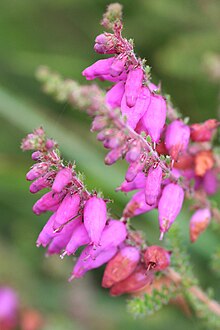Erica ciliaris
| Erica ciliaris | |
|---|---|

| |
| Scientific classification | |
| Kingdom: | Plantae |
| Clade: | Tracheophytes |
| Clade: | Angiosperms |
| Clade: | Eudicots |
| Clade: | Asterids |
| Order: | Ericales |
| Family: | Ericaceae |
| Genus: | Erica |
| Species: | E. ciliaris
|
| Binomial name | |
| Erica ciliaris | |
Erica ciliaris is a species of heather, known in the British Isles as Dorset heath.[1] It grows to 60 centimetres (24 in), and has leaves 2–4 millimetres (0.08–0.16 in) long, with long, glandular hairs.[1] The flowers are 8–12 mm (0.31–0.47 in) long, bright pink, and arranged in long racemes.[1]
Distribution
Erica ciliaris has a Lusitanian distribution, stretching from Morocco in the south, along the Atlantic coasts of Portugal, Spain and France to south-western parts of the British Isles in the north.[2] In the British Isles, it is only found natively in Dorset, Devon, Cornwall and one location in County Galway,[3] where it lives in bogs and wet heaths.[4] It has also been introduced to Hampshire.[1] E. ciliaris was voted the county flower of Dorset in 2002 following a poll by the wild flora conservation charity Plantlife.[4]
References
- ^ a b c d Clive A. Stace (2010). "Erica L. – heaths". New Flora of the British Isles (3rd ed.). Cambridge University Press. pp. 528–530. ISBN 978-0-521-70772-5.
- ^ S. B. Chapman (1975). "The distribution and composition of hybrid populations of Erica ciliaris L. and Erica tetralix L. in Dorset". Journal of Ecology. 63 (3): 809–823. doi:10.2307/2258603. JSTOR 2258603.
- ^ Erica Ciliaris L. R. J. Rose, P. Bannister and S. B. Chapman Journal of Ecology Vol. 84, No. 4 (Aug., 1996), pp. 617–628
- ^ a b "Dorset heath (Erica ciliaris)". County Flowers. Plantlife. Retrieved 28 July 2011.
